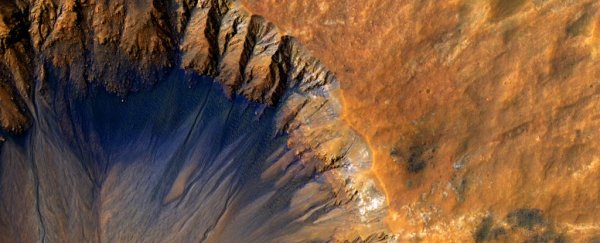A small chunk of rock that once broke away from Mars and found its way to Earth may hold clues that reveal surprising details about the red planet's formation.
A new analysis of the Chassigny meteorite, which fell to Earth in 1815, suggests that the way Mars obtained its volatile gasses – such as certain carbon-based molecules, oxygen, hydrogen, nitrogen, and noble gasses – contradicts our current models about how planets form.
Planets are born, according to current models, from leftover star stuff. Stars form from a nebular cloud of dust and gas when a dense clump of material collapses under gravity. Spinning, it spools in more material from the cloud around it to grow.
This material forms a disk, whirling around the new star. Within that disk, dust and gas begin to clump together in a process that grows a baby planet. We've seen other baby planetary systems forming in this way, and evidence in our own Solar System suggests it formed the same way, around 4.6 billion years ago.
But how and when certain elements were incorporated into the planets has been tricky to piece together.
According to current models, volatile gasses are taken up by a molten, forming planet from the solar nebula. Because the planet is so hot and mushy at this stage, these volatiles are slurped into the global magma ocean that is the forming planet, before later being partially outgassed into the atmosphere as the mantle cools.
Later, more volatiles are delivered via meteorite bombardment – volatiles bound up in carbonaceous meteorites (called chondrites) are released when these meteorites break apart on introduction to the planet.
So, the interior of a planet should reflect the composition of the solar nebula, while its atmosphere should reflect mostly the volatile contribution of meteorites.
We can tell the difference between these two sources by looking at ratios of isotopes of noble gasses, particularly krypton.
And, because Mars formed and solidified relatively quickly in about 4 million years, compared to up to 100 million years for Earth, it's a good record for those very early stages of the planetary formation process.
"We can reconstruct the history of volatile delivery in the first few million years of the Solar System," said geochemist Sandrine Péron, formerly of the University of California Davis, now at ETH Zurich.
That is, of course, only if we can access the information we need – and this is where the Chassigny meteorite is a gift from space.
Its noble gas composition differs from that of the Martian atmosphere, suggesting that the chunk of rock broke away from the mantle (and flung into space, precipitating its arrival at Earth), and is representative of the planetary interior and thus the solar nebula.
Krypton is quite tricky to measure, however, so the precise isotope ratios have eluded measurement. However, Péron and her colleague, fellow geochemist Sujoy Mukhopadhyay of UC Davis, employed a new technique using the UC Davis Noble Gas Laboratory to perform a new, precise measurement of krypton in the Chassigny meteorite.
And this is where it got really weird. The krypton isotope ratios in the meteorite are closer to those associated with chondrites. Like, remarkably closer.
"The Martian interior composition for krypton is nearly purely chondritic, but the atmosphere is solar," Péron said. "It's very distinct."
This suggests that meteorites were delivering volatiles to Mars much earlier than scientists previously thought, before the solar nebula had been dissipated by solar radiation.
The order of events, therefore, would be that Mars acquired an atmosphere from the solar nebula after its global magma ocean cooled; otherwise, the chondritic gasses and the nebular gasses would be much more mixed than what the team observed.
However, this presents another mystery. When solar radiation did eventually burn away the remnants of the nebula, it ought to have burnt away the nebular atmosphere of Mars, too. This means that the atmospheric krypton present later must have been preserved somewhere; perhaps, the team suggested, in polar ice caps.
"However, that would require Mars to have been cold in the immediate aftermath of its accretion," Mukhopadhyay said.
"While our study clearly points to the chondritic gasses in the Martian interior, it also raises some interesting questions about the origin and composition of Mars' early atmosphere."
The team's research has been published in Science.
